I first fished Reekie Lynn as a school kid. I proposed to my wife there. I was there a few weeks back.
A few things have happened in between.
For those who don’t know, this is a farm in the Kamberg through which the Mooi River runs (Mpofana in isiZulu….the Eland). “Mooi” is of course the Afrikaans word for “beautiful”. In colloquial use, we also use the word to say “well done” or “nice”. So for example if you are stalking a fish, and I am sighting for you from a high point nearby, as you set your dry fly on a good Brown, I might stand up and declare “Mooi!”.
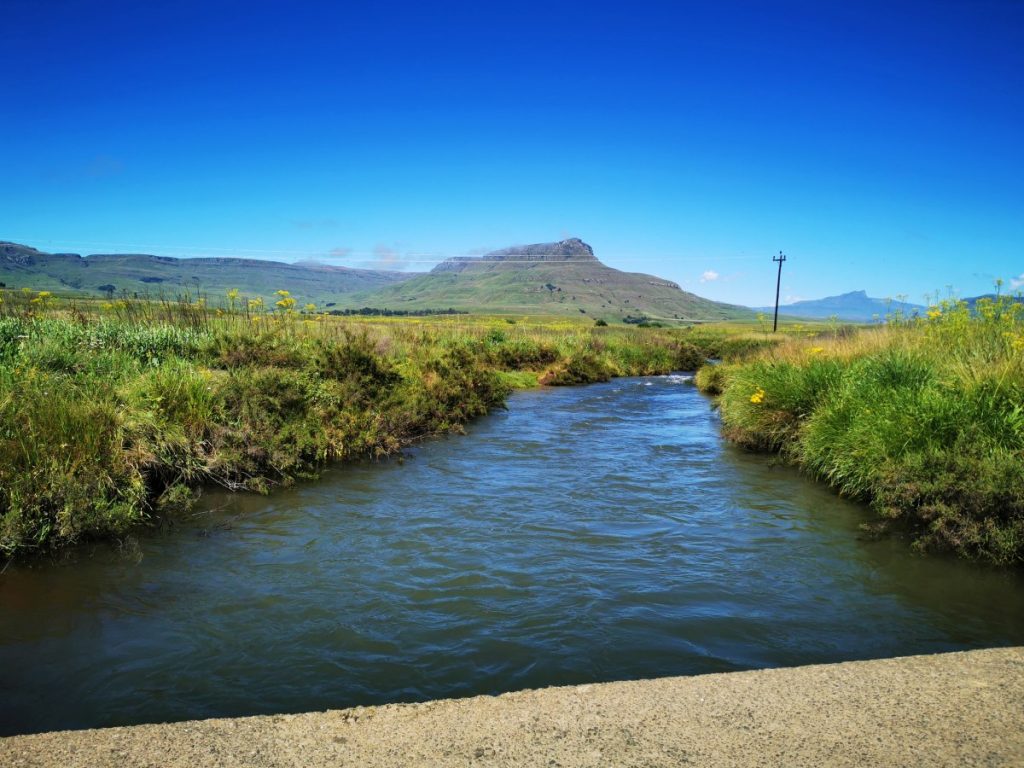
Reekie Lynn is also the name of the tributary which joins the Mooi on the farm. This stream rises up to the east on the ridge that runs from Giants Castle to White Rocks. The stream joins the Mooi at the top boundary, which is just below the slow meadow water of Stillerus, and just before the Mooi tumbles over a waterfall.
This brings me to the name “Reekie Lynn”: Reekie Linn (or Lyn or Lynn) is a Scottish waterfall about 3 miles north of Alyth in Angus. Just below the Craigsla Bridge, the river Isla tumbles 25 metres into a precipitous rocky gorge. Incidentally, in that gorge is a dark cave called Black Dub, where legend has it that an outlaw once hid out, but he gave himself up when he saw the devil in the form of a big black dog down there.
Now I don’t know that we have any black dogs down there in the few tiny overhangs on the Mooi, but we do have a gorge of sorts. Not a black rock, vertical sided thing like the Scots have, but a deeply incised valley nonetheless. It is in this winding valley, closed in by rocky hills on both sides, that you fish our Reekie Lynn. That makes it a place where you don’t go if you have a bad leg, or a fear of doing an ankle, or a cocktail party to get back for.
What Reekie Lynn is about, is losing yourself completely in a valley of solitude and escape. This is a place you go to when you want to forget to look at your watch for seven hours. This is where you go when you plan to get back so late that no take-away places are open for some supper on the way home. You want to fall into bed after a day at Reekie Lynn, and need a rest day when you wake up. Well, that is what it is for me anyway.

First off, you need to know where the beat goes. That is to say, you need to know how much water there is and where it starts and ends. If you have this right you will be picking a section of it for your day’s fishing. If you think you are going to fish it all in one day, then very clearly you haven’t worked out where it starts and ends.
I must be a bad guide because I have described with care to so many anglers how far down you need to go to the bottom boundary, and in most cases, they later let slip a piece of info that tells me that they didn’t even get halfway there. I have seen a bunch of people on public forums discussing the “lower section” of the beat, and all of them are referring to somewhere well above the halfway mark! So for me it makes the lower bit all the better, because I know that the fishing pressure is exceptionally low down there.
So if you do make it down to the real bottom boundary, you have earned your stripes, so to speak, and you should feel just a little bit smug in the knowledge that you are one of just a handful who go down there.
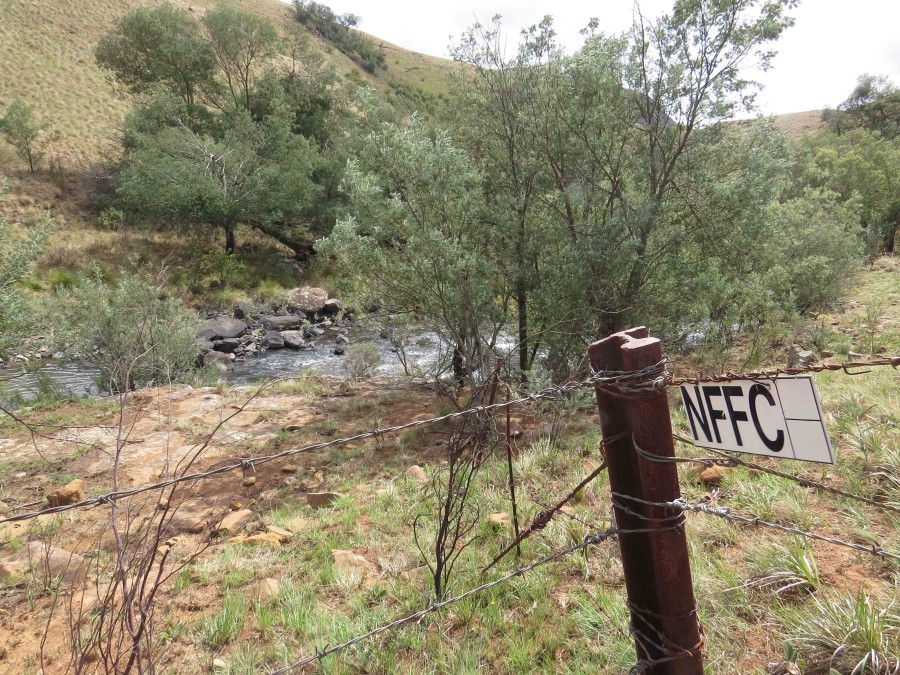
That bottom piece is joined by a stream that comes down from Dargavel, and joins the river at a particularly good pool. But before we get to that pool: From the very bottom of the beat, where recent wattle clearing revealed the old club sign I hung on the fence well over 20 years ago, is some good pocket water.
This last April I hooked a number of fish in the deep little sloot opposite where the fence comes down. If I had let my back cast rest on the water, I would have been poaching on the beat below, but my toes were over the line. Since no water bailiff has ever been down there, you will have to take my word for it. Based on that I guess I could tell you that I landed all those fish, but I didn’t. They just wouldn’t stick! Just above that spot, safely within the bounds of the law, is that piece of pocket water. I have to confess that I often used to ignore that, and start in at the pool above, but you do that at your own cost. That pocket water is mighty fine. It is the kind of spot where you can wade into the centre and then move a little left or right of that to fish a tongue of current here, a flat spot there, and so on. In the autumn it can look a bit thin, but you will be amazed at how fish appear seemingly from nowhere to hit a dry fly. You look later to try work out where it was sitting, and most often it is a little depression in which you would barely fit your coffee flask.
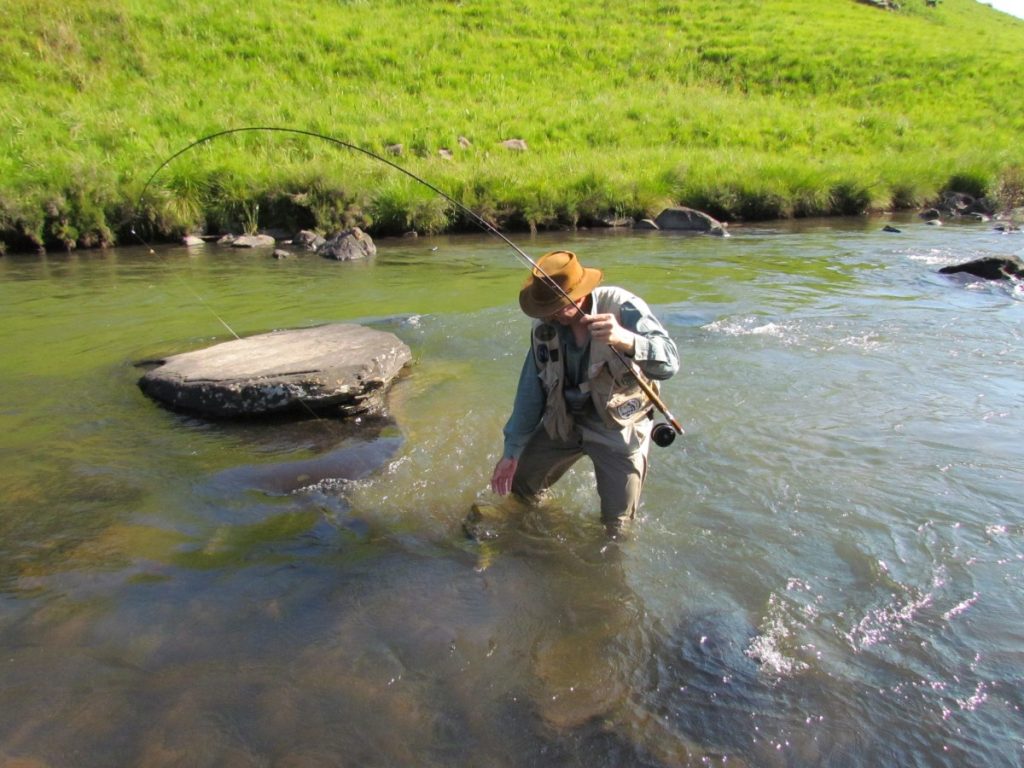
Coming to the pool at the Dargavel stream confluence, you would do well to scan the tail of the pool before letting loose with a cast. Feeding fish are known to move into that fine clear water. The gravel there is a delightful pale sand, so spotting a fish there is not as difficult as it is elsewhere, but of course because of that, they will be as skittish as a kid chasing his football across the freeway. On the right-hand bank of the pool is a big wattle. We haven’t dropped that one, because we have no way of getting it out of the pool once it is down. Beneath that tree is a deep dark shaded spot, but it isn’t as deep as it looks. Further up, the pool assumes some real depth, and even in gin clear flow, develops that deep green look that just shouts “big Trout!”.
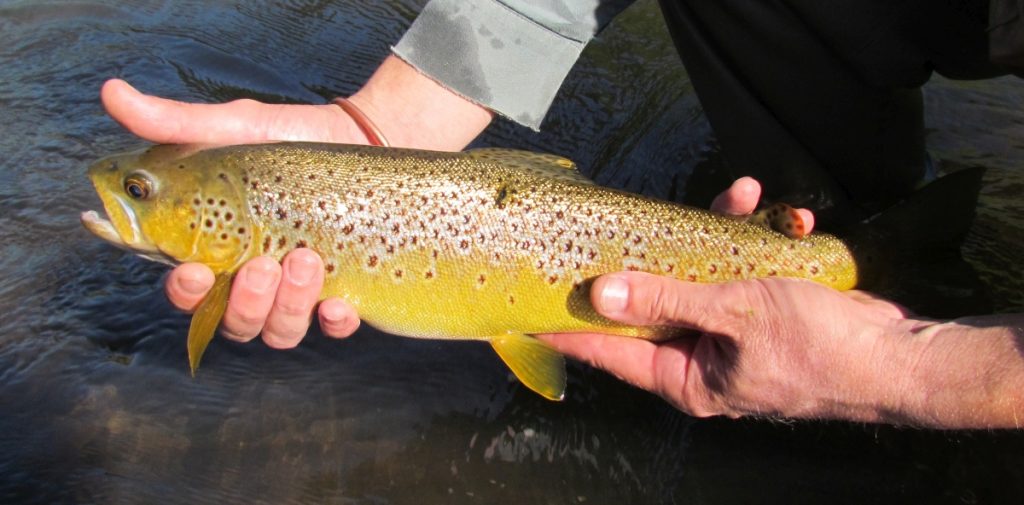
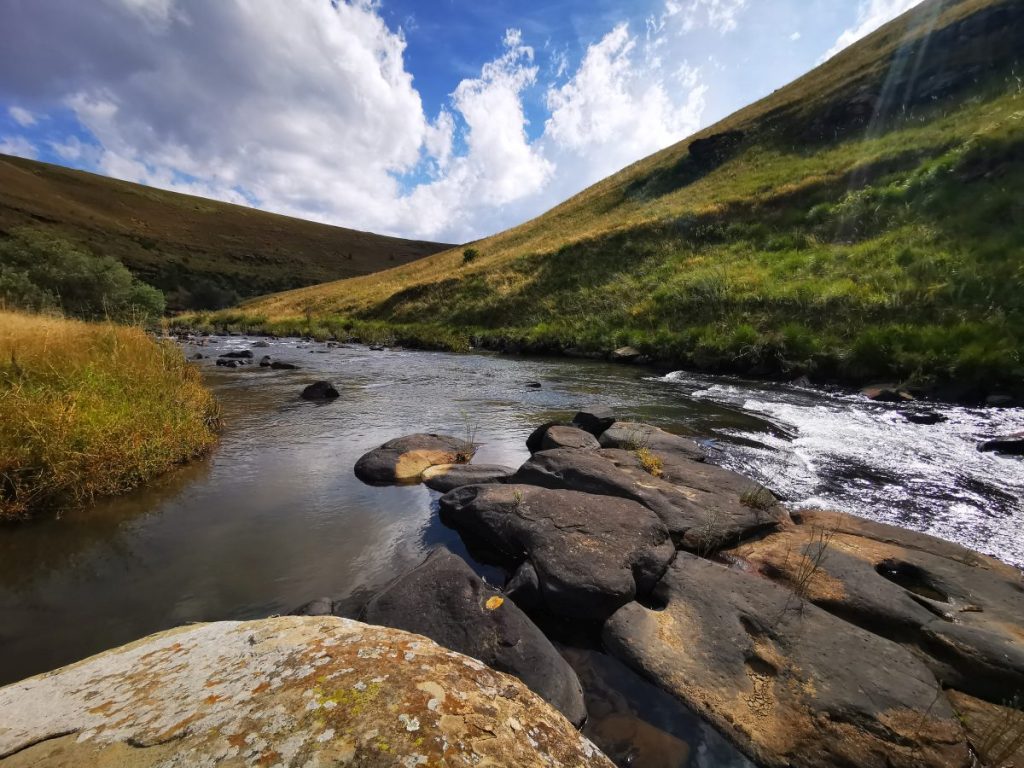
Now just above the pool is some fast, bedrock water, which I haven’t paid much attention to, but just above that is a flat rock where I have often pulled the stove out of my pack to make a morning coffee. Let me tell you, the run above is some of the most productive water I know. When you hit it right, you can sit there with your cup of coffee in one hand and raise fish by flicking a fly with the rod in the other. There is a lip, just before the water pulls over into the tumble of white crested stuff below, and the fish sit just above that lip, and hunt for stuff coming down to them.
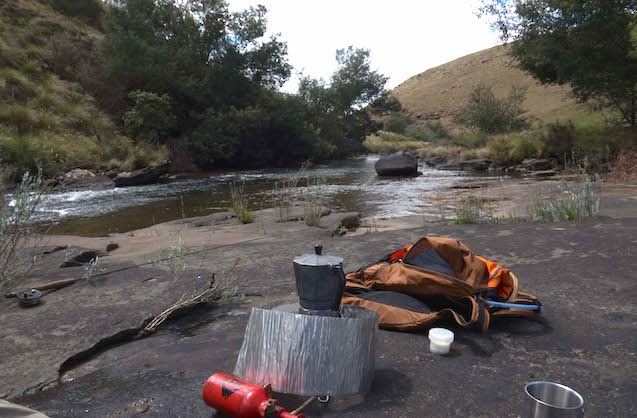
Once you have packed the stove away and shouldered your pack, you can wade and fish the broken water just above that, and on up into the big pool there as slowly as you care to. And I recommend slow. I recently dwelled there for so long (and justifiably so!) that when I got to the head of the pool it was lunchtime. The head of the pool has a really productive double run. By that I mean the water enters a zone of headwater, which is fishy, then speeds through a slight narrowing and only then enters the pool proper. Depending on the day, and of course the flow, the fish may be in the headwater, or that could be empty, and they all sit in the main pool. Like all Brown Trout, the place they are most likely to be is in the deepest spot, where the flow dissipates and slows to walking pace.
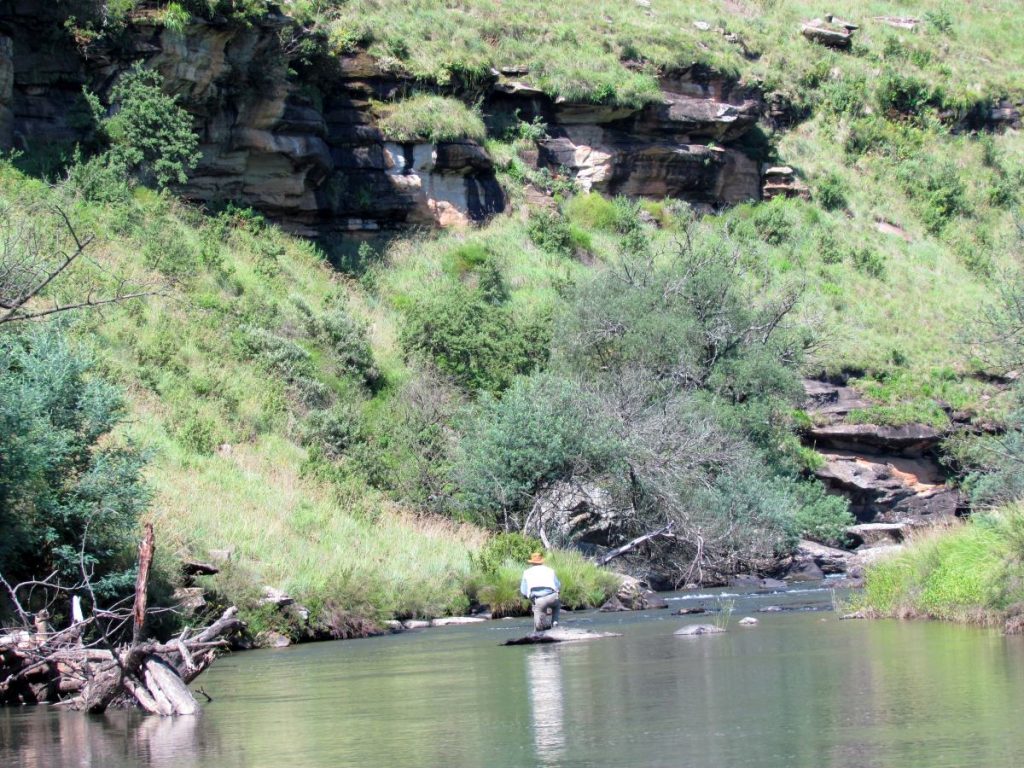
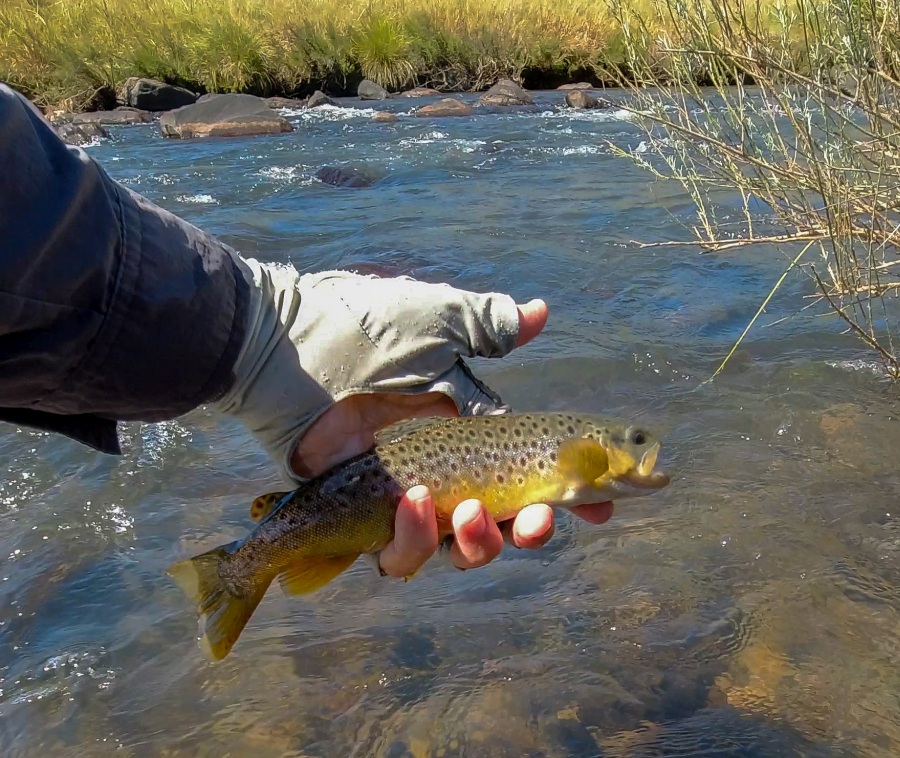
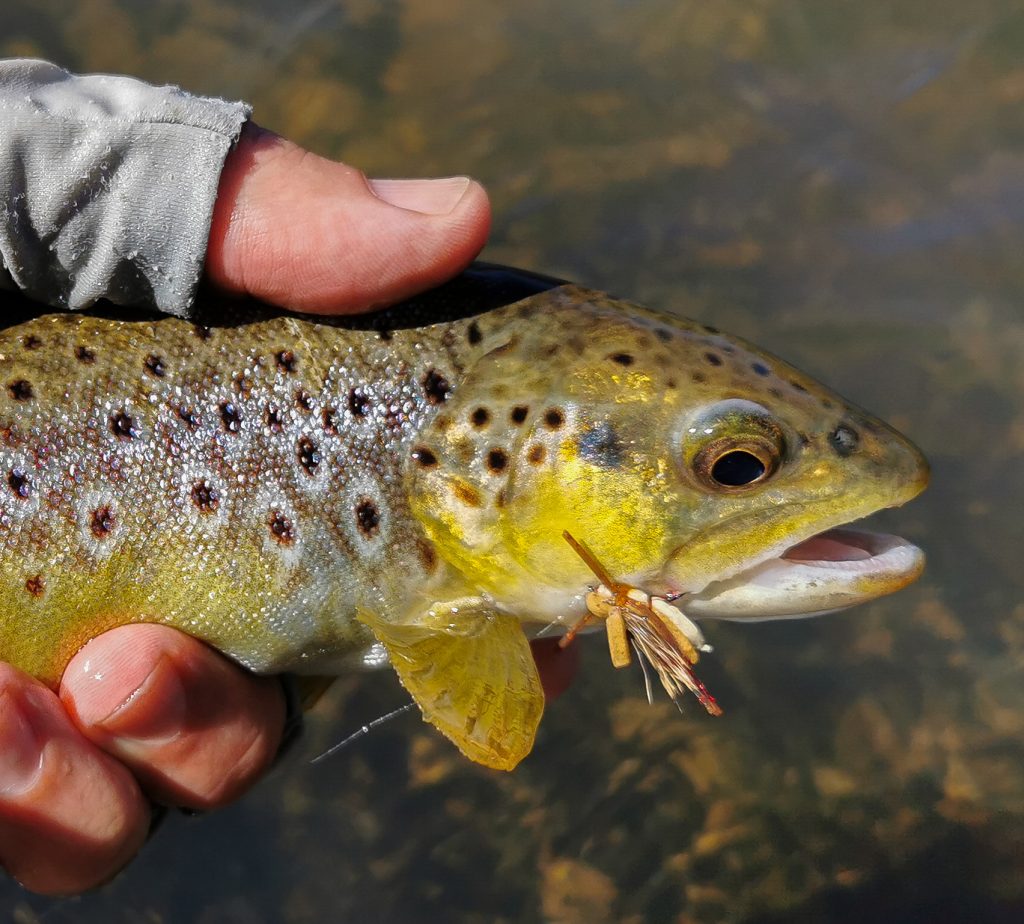
Now from this spot, you can either climb out on the left bank, and clamber up the slope in search of the Bushman paintings, or you can fish on. The paintings aren’t great, I must admit, but I didn’t feel I could say I know the place without having taken a look at them.
Back down in the river, you start encountering that fast deep water which looks better on the lid of a box of biscuits than it does to a fisherman. Well, this is how I used to think of such water, but then, way back in my youth, Roger Baert lent me a VHS tape featuring Roman Moser, which caused me to change my mind. Hence the name “Moser’s Run”. In that tape, Moser fishes a deep, fast, almost scary canyon, in which he risks life and limb to get into position in the cascading white water. There he selects a small flat patch the size of the spare wheel on your bakkie, and he masterfully extracts fish after fish. It was with this footage in mind that I started to fish Moser’s Run more seriously. While I have never extracted fish hand over fist like the master did on that tape, I certainly have done better. That spot was shrouded in wattle for many years, but successive clearing has opened it up beautifully. Likewise, the pool above is now so much more approachable. “The Drip” as I call this one, has a unique feature: a waterfall, direct into the pool. ‘Waterfall’ is however a grandiose term for what is often just…yes…a drip. Either way, the water drops in off a cliff on the south bank, the same cliff above which you will find the cave paintings. Funny…I don’t think I have ever caught a fish in this pool, despite running the fly down the far side and in under the overhanging rock, in the dark and mysterious band hugging the rock face. The head of the pool is a tumble of really fast white water, even so in times of low water.
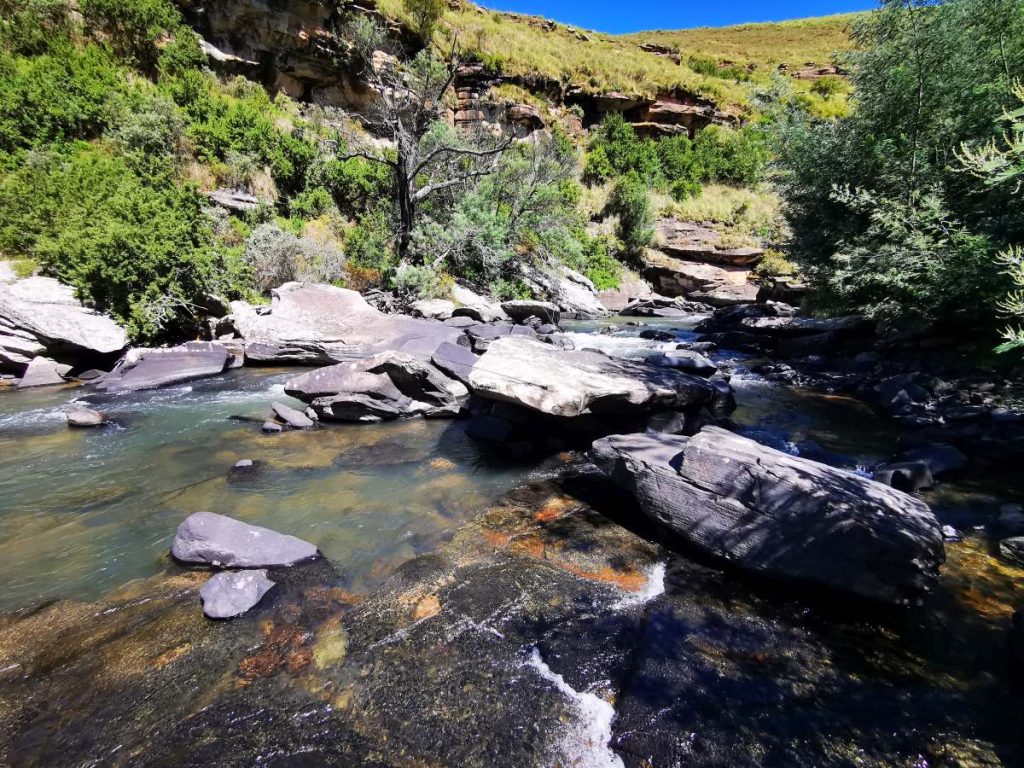
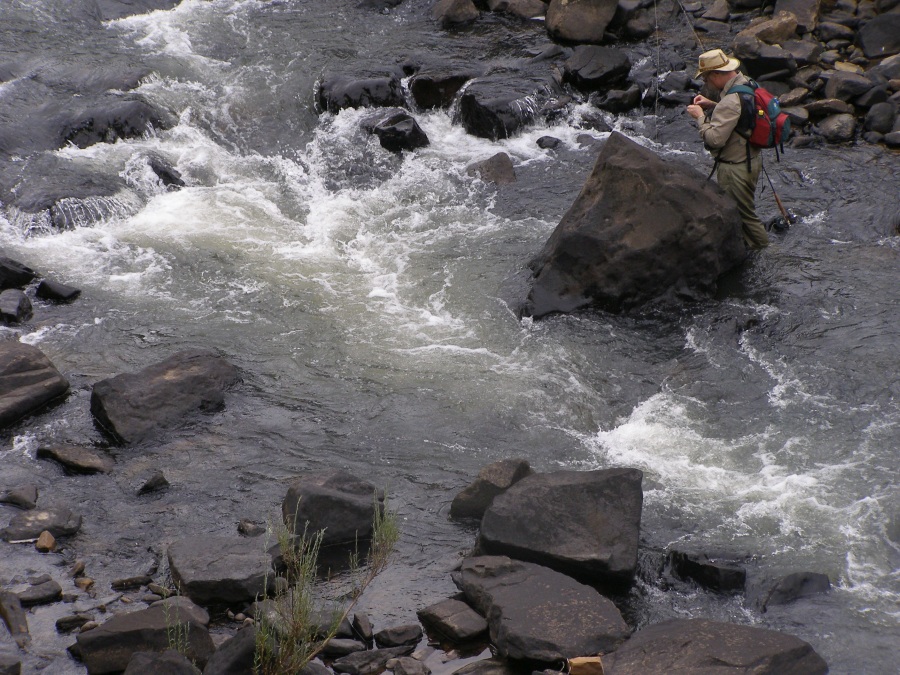
Above this the river widens and again there is a succession of runs, and small pools all the way up to Magic Pool. The south bank has wattle on it, and while we have thinned it, a band of trees which would remain in the river if felled, has been left along that side. So you need to fish this from the north bank, or waded in. There is some good water in here. Some patches are a bit thin in low water, and in those conditions you would be forgiven for skipping them. Others do have some deeper gullies and no doubt will hold fish in most conditions. But I haven’t given this section the attention it deserves. Call me prejudiced, but there is a limit to how long I can spend fishing in under wattle trees.
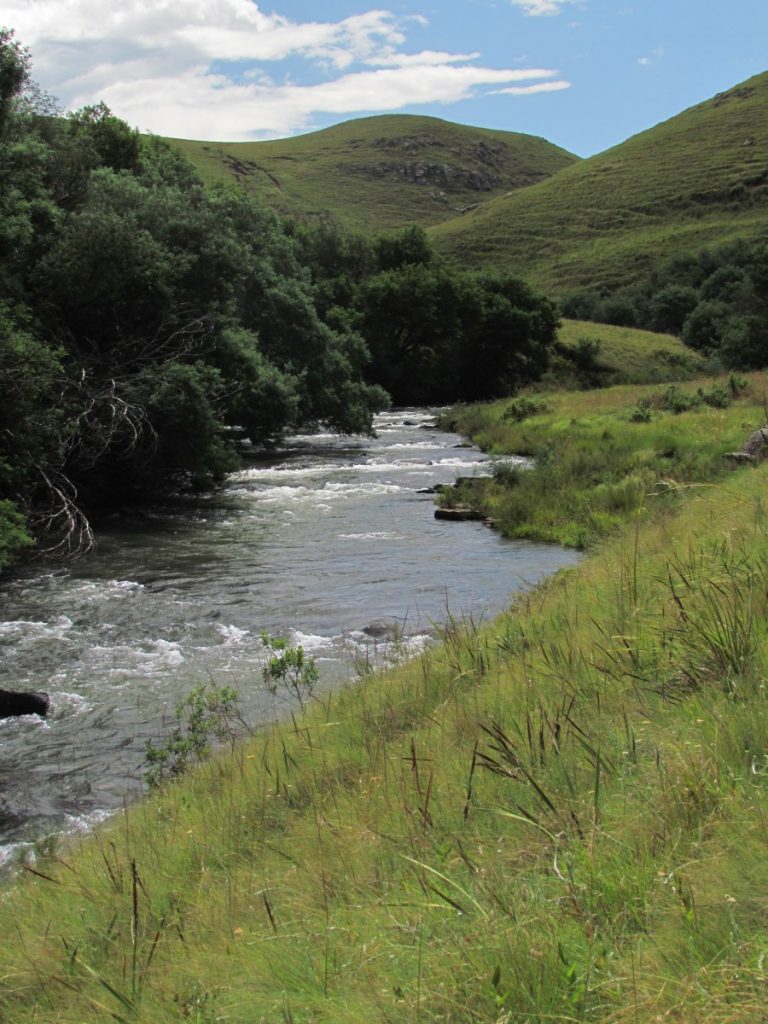
Up ahead is some pocket water at the outflow of Magic Pool, and this is back in the open. It is a particularly productive area, but beware, it makes for hazardous wading. Some spots on our rivers just are this way. It is a zone scattered with angular dolerite boulders, with crevices in between. The perfect spot to do an ankle! And yet somehow this is the spot where we always cross, fishing as we go of course, to access Magic Pool from the South side. Magic Pool does need to be accessed from the south, given the cliff on the north side.
Now Magic Pool didn’t get its name for nothing. If you want to take a kid, spouse, friend or other to a river to catch a Brown Trout, take them to this pool. It’s simply magic. Now, I probably have blanked there before, I am sure I have, but I struggle to recall such an event. I blank in a lot of places, so that really is saying something.
From the tail area of the pool, there is a more shallow zone, with water drifting over a zone of bedrock, cut through with deep crevices, and coupled with more of those angular block-like boulders. You think you can see the whole bottom, but be that as it may, if you are stealthy enough, fish appear from out of that and smack your fly with gusto, in full view. I am forever puzzled as to where exactly, they come from! I have had days there where I have felt I have almost had my fill, before even fishing the pool proper. This last season, I went there on my own, and in order to show you what I mean here, I waded over to the other side, and set up a camera. Then I waded back, got into position, and proceeded to demonstrate why this is called Magic Pool.
Once you have fished this sort of “slide out” section of the pool, you get to the great big pool itself. For the sake of a drag-free drift, I pretty much ignore the far side and fish the zone on my own bank, and then out into the main current. Running up the left side is a shelf of rock. Fish dart out from under that shelf and smack a well drifted fly with gusto. The main current through the pool varies from time to time. There is a strong flow towards the far side. In lower flow, this is the stronger of the two, and with limited interference from the flow coming in from the left, you can put a long cast up into the teeth of this thing and get some fish up there. But when the flow is up, the left side inflow gets strong enough that a drag-free drift out of the right-hand flow is not possible. In that case the shelf I described above gets even better, and because you have white water on the surface, which hides your presence better, you can keep on harvesting fish from under the shelf for longer. In low flow you reach a point where you are not getting takes, and you can say “its done!” and move on. In stronger flow, you can stay there and catch fish for a lot longer.

If you walk up the south bank and get to where these two tongues of water flow in, there are some good spots to stop for a bite to eat and maybe one more cup of coffee. In normal flow, you can hop over the first inflow, and make your way to a lovely big rock, just flat enough to rig up a stove. But amazingly, I have been there when there is no way you could hop across. I say ‘amazingly’ because in low flow it is hard to believe that it could come up that high.
Above Magic Pool, and still in the shadow of the cliffs on the north bank, is some more fast, deep water like that I described at Moser’s Run. The river bed is quite narrow here, so I don’t call this pocket water. It has deep dark holes, and fishing it means jumping from large boulder to boulder, and choosing a route with care, rather than wading up whisking a fly here and there. Until recently this spot also sat behind a curtain of wattle on the south bank, and I have fished it less than other bits of water, but I certainly have taken fish there.
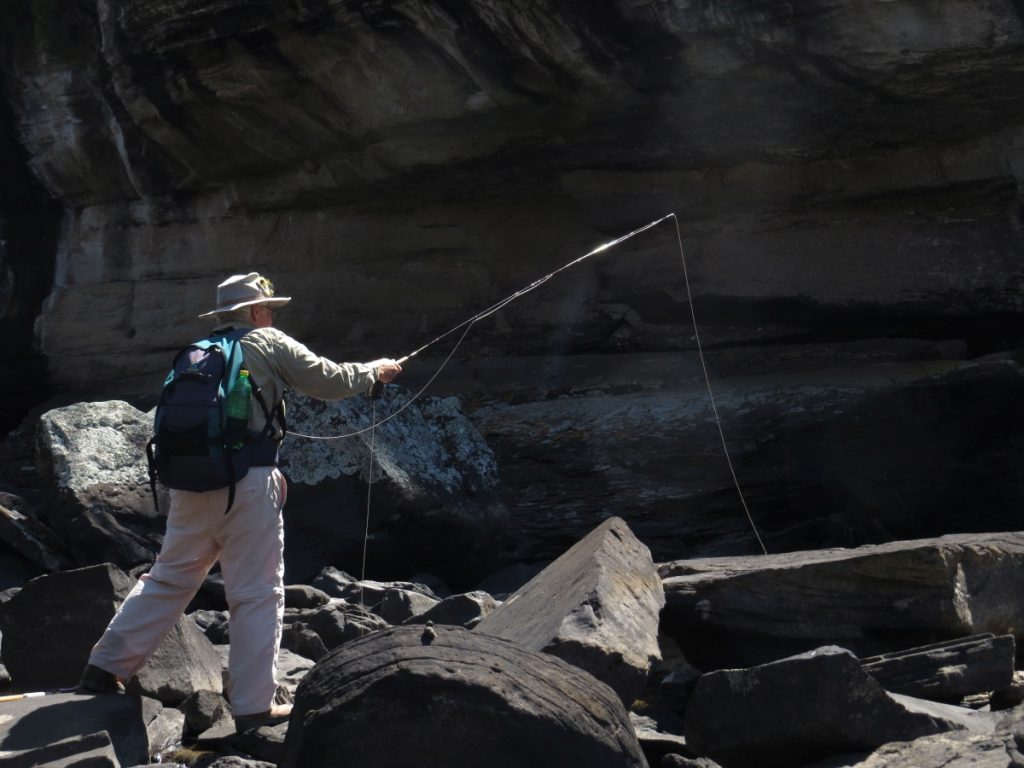

Looking upstream, the river takes a left-hand turn of about 45 degrees, there entering some pocket water that I just love! I can (and do) spend hours here. It is only difficult to wade in the very strongest flow. For the rest it is fairly easy going. Having said that, like anywhere I suppose, you could do an ankle here too. This piece of water has been magnificent for me. In fact, as I sit here writing in the dead of winter, I feel a distinct itch and yearning to go up there right now and fish a dry dropper rig through there for a few hours. There are multiple seams, and anywhere that slows even slightly, is productive. The last time I was there, a hatch of small soot-grey caddis was coming off everywhere, but I couldn’t raise a fish on a floating caddis imitation. Then I changed to a #20 Pheasant Tail Nymph, and oh boy…I couldn’t go wrong!
From that pocket water, the river kind of morphs into another ‘slide-out’ section at the tail of Krantz Pool. The krantz is now on your left as you look upstream…..the south side. By now you will be getting the idea that as the river twists and turns in successive bends, the steep side alternates from side to side. Now that slide-out section, with slightly increasing flow rate, is a continuation of the superb water from the pockets below. It is not uncommon to encounter rising fish here. I suppose that is true of any tail out, but this one is a little deeper than most, especially along the south side. I don’t always come away from here with a fish to my name, but I have caught some truly magnificent fish in this spot.
Having fished the tail, you will need to climb out of the river on the north bank, on account of the depth, and you can then fish the pool from the bank, with a long cast across to the stronger current on the far side. But mid-way up the pool it is more shallow. There is a rock shelf there, which leaves a big patch on which fish will no doubt feel more vulnerable. Up towards the top it gets deeper again, and here you encounter a classic pool inflow which is also very productive water. Sometimes I find that run into the pool almost a bit too text-book, if you know what I mean. Everyone will identify this as perfect water, and fish it. It’s that obvious. And for that reason, I sometimes pass it by. I know, it is an obscure idiosyncrasy of mine.
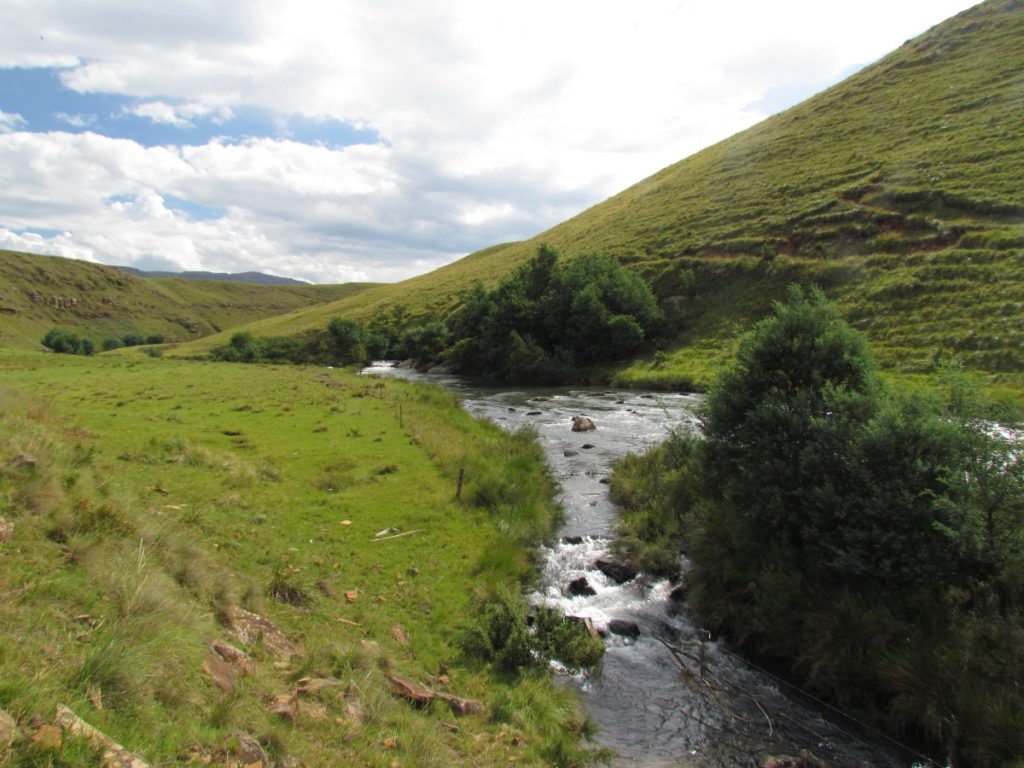
Now above Krantz pool, is an island in the river. Above that is some lovely pocket water again, and then a pool, at the head of which is another island. So this pocket water plus pool is named “Island Pool”. So let’s start with the pocket water. Man I love pocket water! This one is deceptive. The river is wide, and it can look, and be, rather shallow in low flow. But even in low flow, it is full of surprises. It isn’t called pocket water for nothing. There are fish-holding pockets in there no matter the flow, and I have done rather well here too, although I have to say, not as well as the piece just below Krantz Pool. You will need to cross the river here to get back onto the south bank, in order to fish the Island Pool itself, so wade and flick the pocket water if nothing else. The wading is easy.
Then there is the pool. In many ways this is similar to the first pool I describe in this piece: Wattle tree on the steep north side. Shady , but not as deep as it looks, deep green water above. Screams “Big Trout”. I have caught many fish here, but alas, not that big one.
Now if it so happens that a wild storm bursts upon you somewhere near this spot, I can recommend that you turn around, get through the fence, and sprint straight at the line of little cliffs that run along the toe of the slope behind you. When you get there you will find a couple of little shelters. Little caves that you can crawl into or sit in, out of the hail and lightning.
Above Island Pool, and its upper island, you will find Scissors Run.
Now at this point you should be saying “How the hell did this one get its name?“.
One tries not to name these pools in a way that is so personal that it is meaningless to others, and says nothing about the features. You will note that there are a number of runs and pools that remain unnamed too. That is because it would be presumptuous of anyone, me included, to be the one to name all the pools on a river. So many are left un-named in the hope that other fans will come forward with their own names, and we can stamp them on there. We are coming to one of those just upstream of where we are now, but until then, and as to your question: why “Scissors Run”?
Well you see, it is a very productive stretch of knee- to waist-deep water, which roils, and glides and slides attractively and every square inch of it is prime holding water. That is why a mate and I will often stand side by side, chatting and fishing at the same time. You can do that here, and it doesn’t take anything away from the quality of the water. So PD and I were doing that one time, and I was putting on a strike indicator. The river was up, and flow quite strong, but the river was beautifully clean. I got the indicator on, and then extracted a small pair of folding scissors from my vest to trim the yarn down to something respectable. At that point I dropped the scissors. Looking down, I saw them sitting on the gravel just off the toe cap of my wading boot. The current was pulling at them, lifting them just slightly, and threatening to carry them away. Now I was waist-deep in quite fast water, and to lean down to get them would involve an almost complete immersion. So at this point I asked PD to shuffle closer, and hold some stuff for me. With my feet dead still, I proceeded to strip down, and hand everything to PD, who stood there like a waiter, arms outstretched, holding vest, camera, rod, net etc. Then I took the somewhat chilly plunge. I emerged completely doused, grinning, and holding those precious lucky-packet scissors. I still have them.
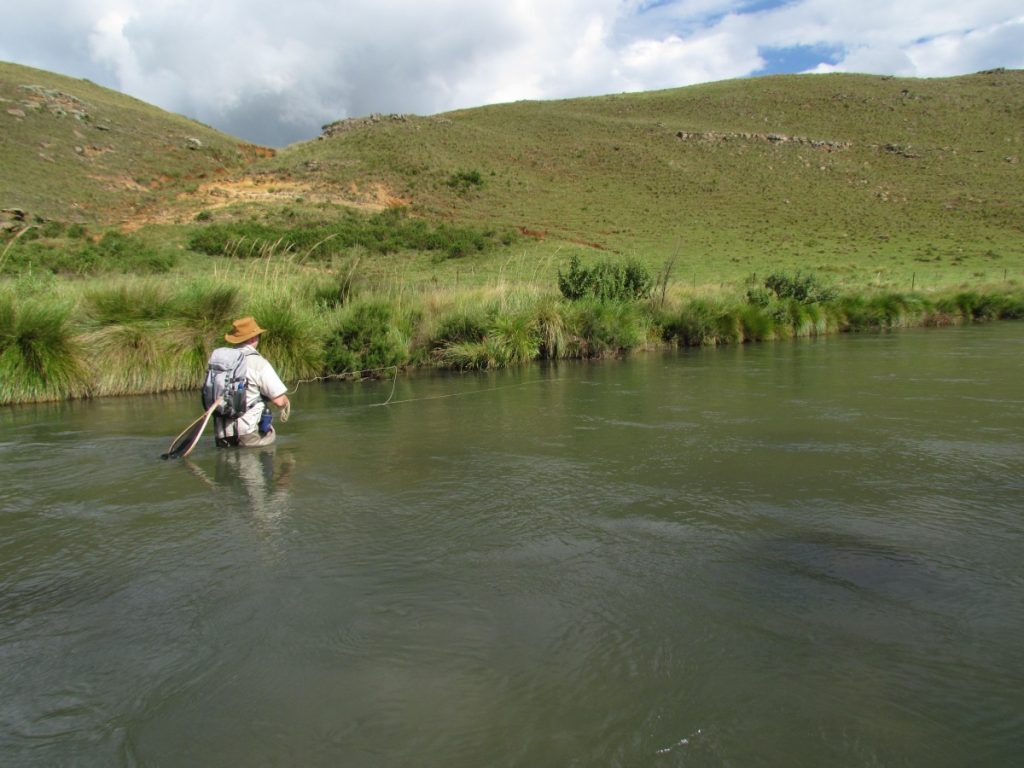
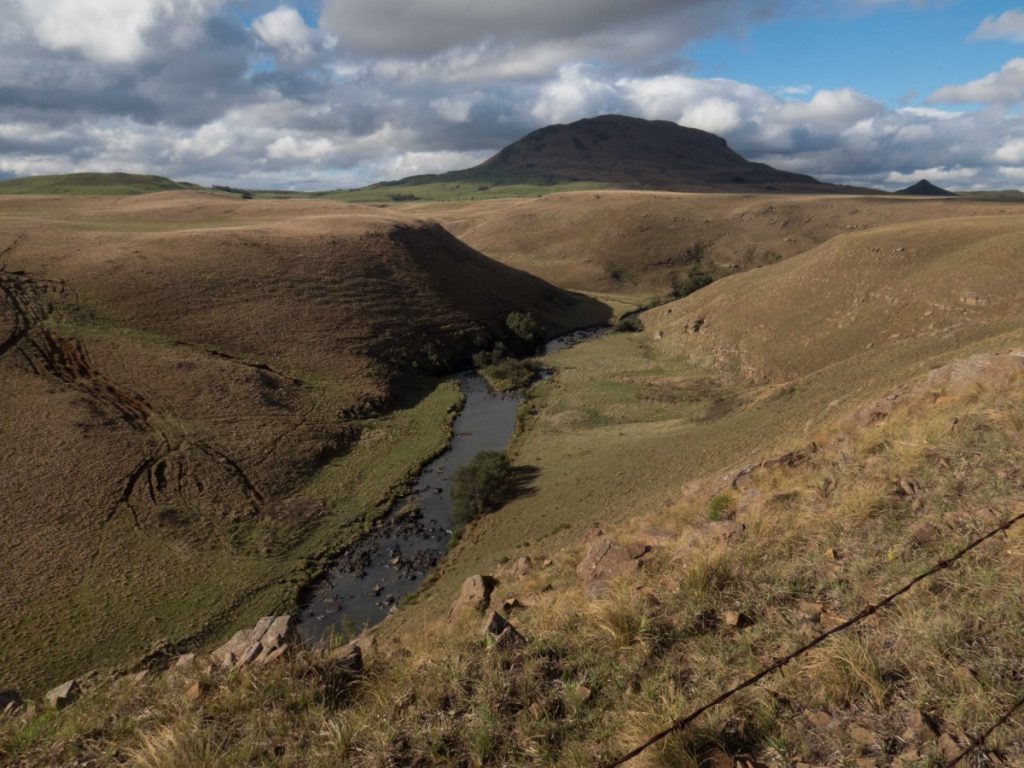
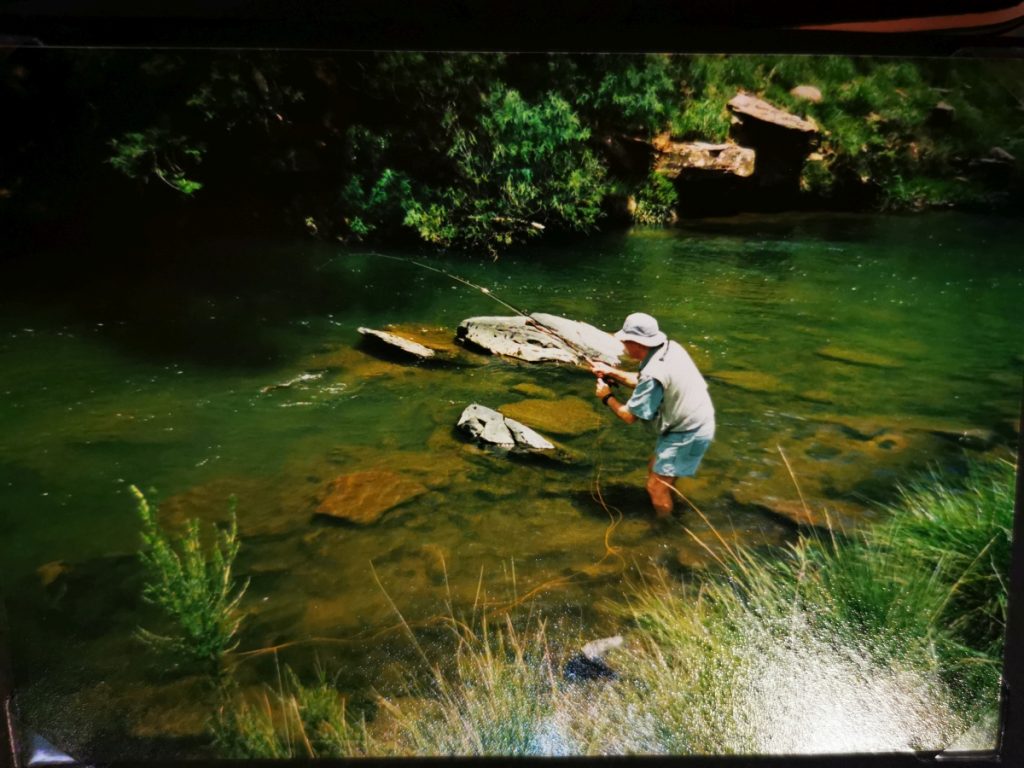
As you get higher up Scissors Run it turns into more of a typical pool. In fact it gets way too deep to stay in the river, and on account of what is coming up ahead, you move right and climb out on the north bank to fish the top end. It is absolutely lovely water ….another classic inflow into the pool, and as productive as the rest of Scissors Run.
Up from there, you again have a steep south bank. Not quite a cliff perhaps, but steep, and sitting below that steep bit is a monster of a pool. I have done OK here, but I have yet to hook the beast that surely lives in this thing. I say surely, but a few years back a friend did hook something I here. Something that defies description him and his companion that day, tell me. And they named that fish “Walter”. So Walter’s Pool it is. I have a fantasy of sorts, that involves fishing this in the dead of a moonless night, but let’s not go there.
Above Walters you arrive at a spot that may at times require the wearing of a clothes peg on your nose. This is called “Cow Drop”. The vulture restaurant sits up above on the crest. Say no more.
If Cow Drop is not occupied by a bovine stink bomb, there is a plunge pool there with the most incredible swirling back eddy. I am useless at fishing these things. I just don’t know how. No matter what I do my line is tugging and my fly is dragging the moment it hits the water.
Just up from this dolorite section, and its fast white water, is the tail of Tekwaan Pool, and again, you need to cross, from the north to the south bank this time. It is the only place to cross, and it is not great. The dolerite is angular and wet and slippery, so I tend to climb into the very tail of the pool to cross there, but the bottom is still all angular rocks and deep holes, and the thing is waist deep, seldom less.
Now Tekwaan Pool is a beast of a thing. Look out for the Tekwaan…Zulu for a Hamerkop…Hammerhead…that strange silent bird to which the Zulu’s attach great superstition. The tail of the pool is flat water, deceptively deep, and with deep grooves in the bedrock, where Trout hide. This is great Trout spooking water. Don’t say I didn’t warn you! The bank is also a bit high, and it is too deep to wade. If you suspect there are fish there, my best advice is the leopard crawl. I have landed some quite good fish here, but I have definitely spooked a lot more. Take your time.
Further up the pool, there is a shelf on the south side that you can wade onto in most flows. That gives you casting access, albeit with a long cast, to the far side, and up into the heart of the pool. It is still flat water, but it is productive. I think I have seen more fish rise in this pool than most others on the river, but on reflection that may have a fair bit to do with the time of day at which I typically arrive here. I also find it doesn’t offer up its fish anywhere near as readily as Magic Pool. Up at the top there is a nice textbook inflow, and fish are to be had in the thalweg, as is to be expected.
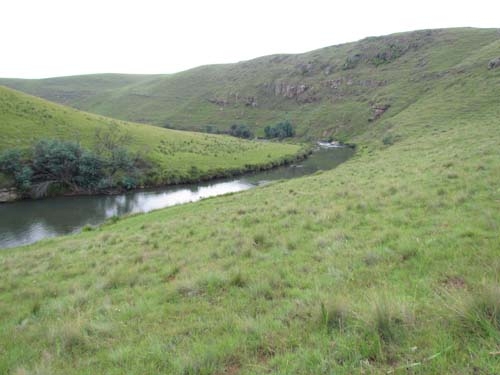
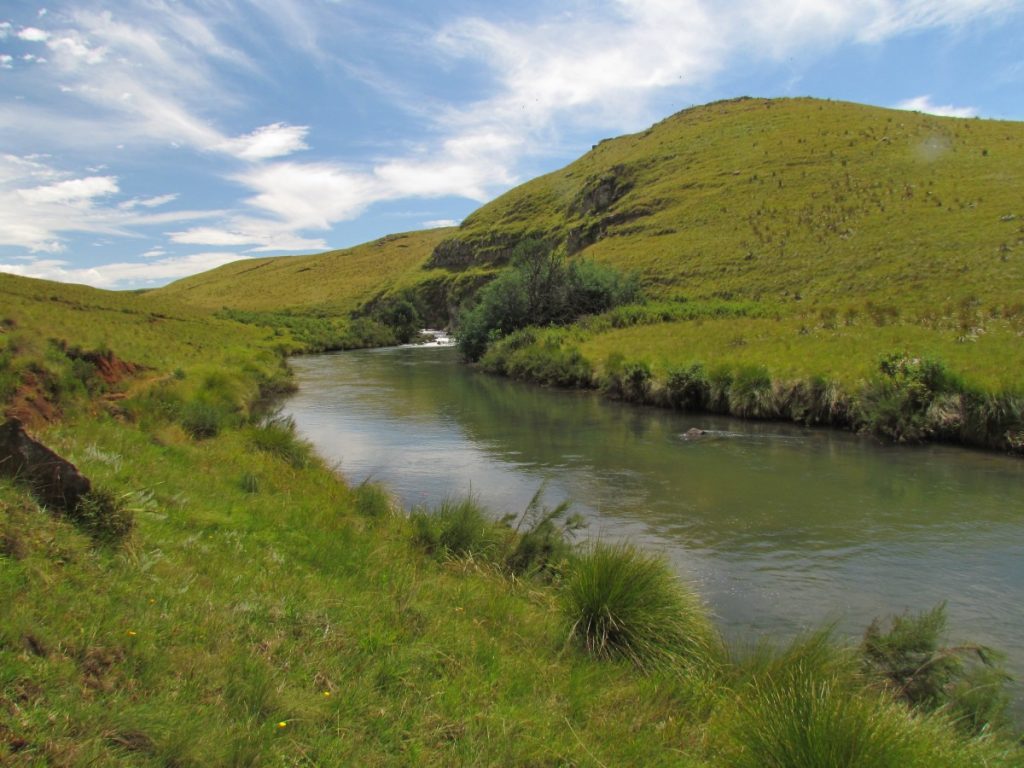
Immediately above Tekwaan, and still below the north bank cliff, is a very shallow bedrock piece of white water, which is very pretty to look at, but no more. But as you move up, it starts to develop some pockets, and a deeper slot on the far bank in particular. As you approach the tail of Picnic Pool, the one above, its status as prime pocket water increases, and I have done rather well here.
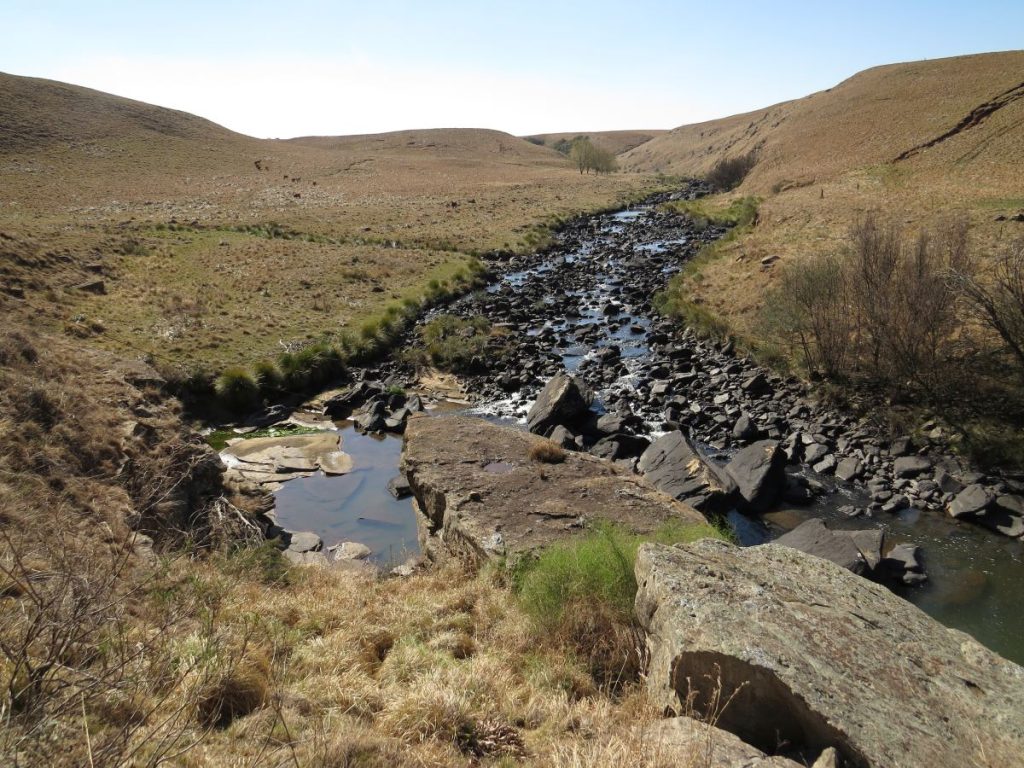
Picnic Pool itself is very pretty. I find myself drawn to the south bank, and clambering up the steep side, looking down into the pool between house size boulders into the green depths, that sort of thing. I have seldom fished it from the other side, but that is without doubt where you should be if you are serious about getting some fish out of here. But on the south bank is picnic rock, which you reach by clambering up the steep side, and then slithering down onto this big flat ships-prow shaped rock. It has the makings of that rock from which the Lion King was held aloft. It also has a beautiful view up the valley towards the plane trees. It really is a beautiful picnic spot. The sort of place where you might propose to your lady. I did.

Now at this point, you are tired, and it is getting late. Your day is done. The bakkie is just above you at the roadside beside the lower of the two club fence stiles. There is also plenty of fishing still to go above this point. But you have now reached the point which the vast majority of fishermen think is the lower boundary of Reekie Lynn! Remarkable isn’t it! I mean we have caught, what was it, 15 or 20 or so fish…I don’t know…I forgot to count, and we have covered kilometres of river and we are tired. And apparently, we are at the lower boundary.
Of course I have fished the bit above, like a lot of people, but I am drawn to the piece I have described here. It is a longer walk. You are less likely to encounter footprints, and more likely to see an Eland. Half-day anglers won’t go there. Is it better? Probably not. Are the fish bigger? Probably not.
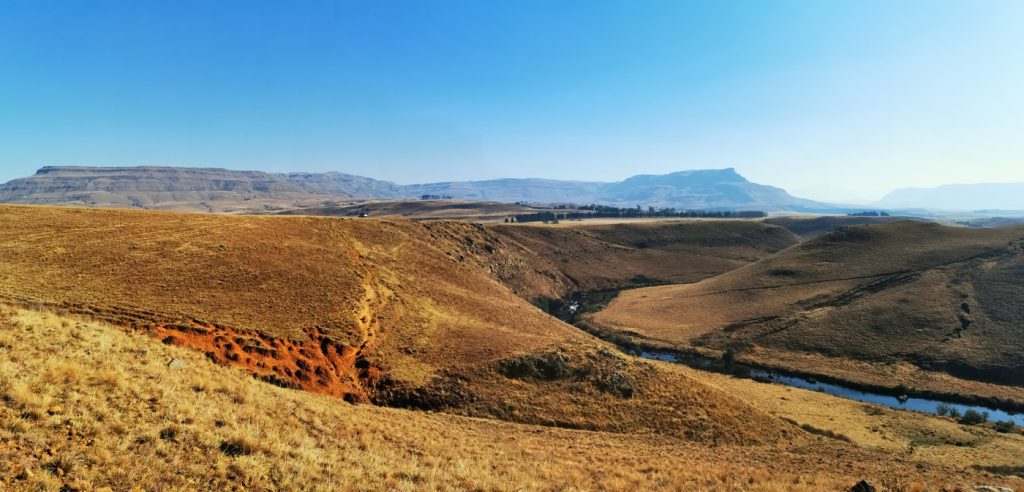
You wouldn’t want to do an ankle down there. There is no cell phone reception. But it is a place that I celebrate. No black dogs down there.
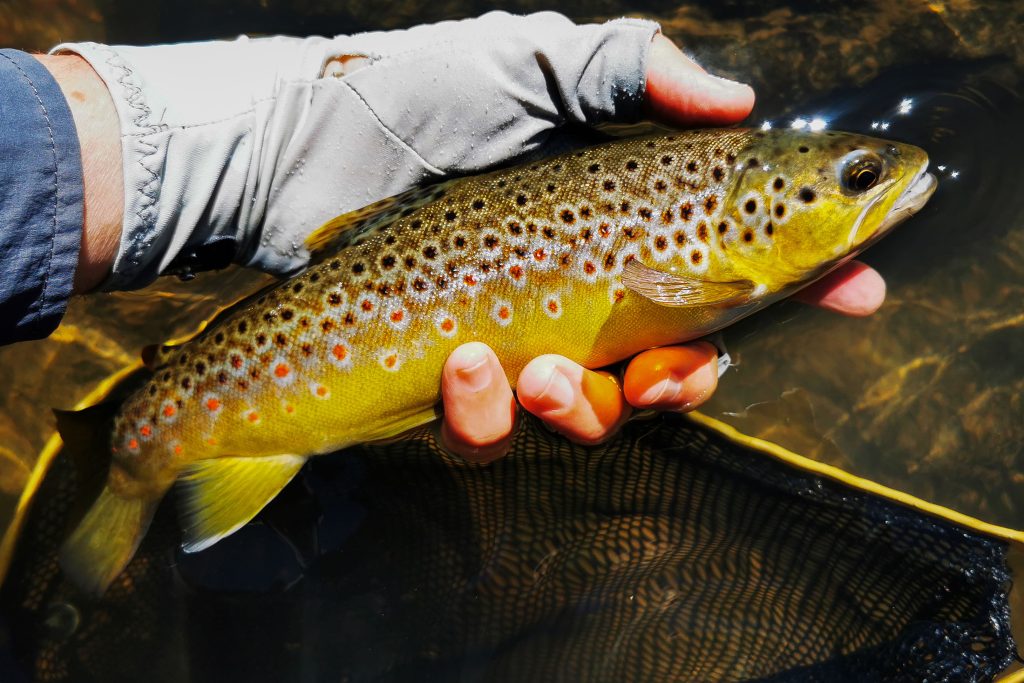
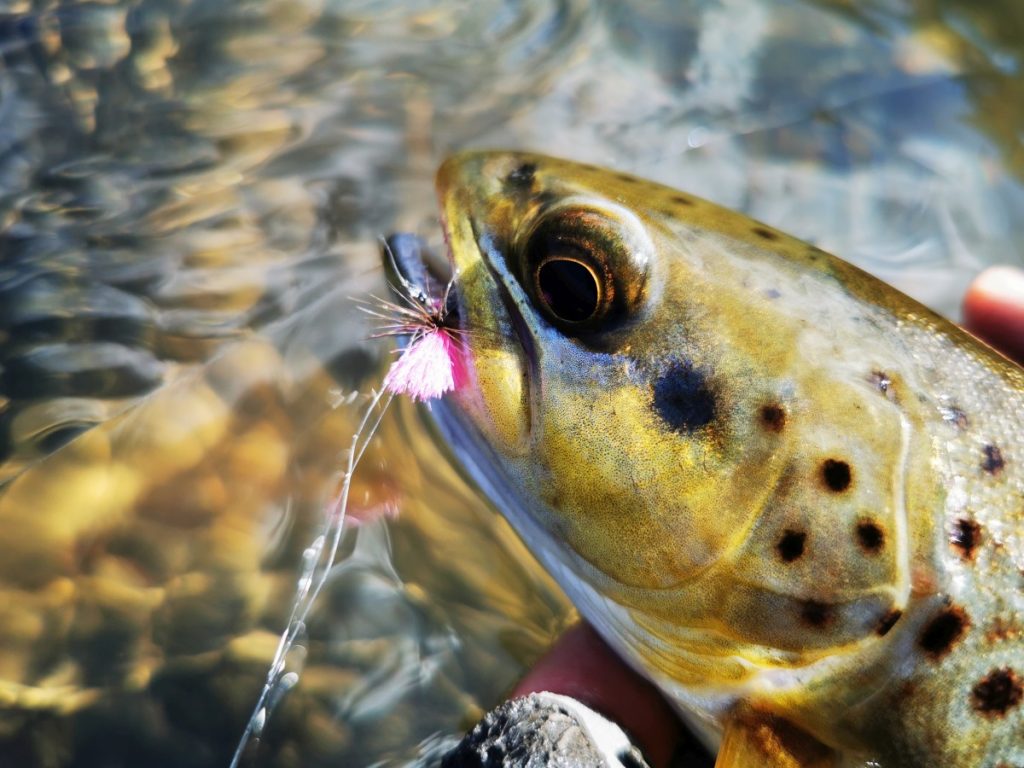
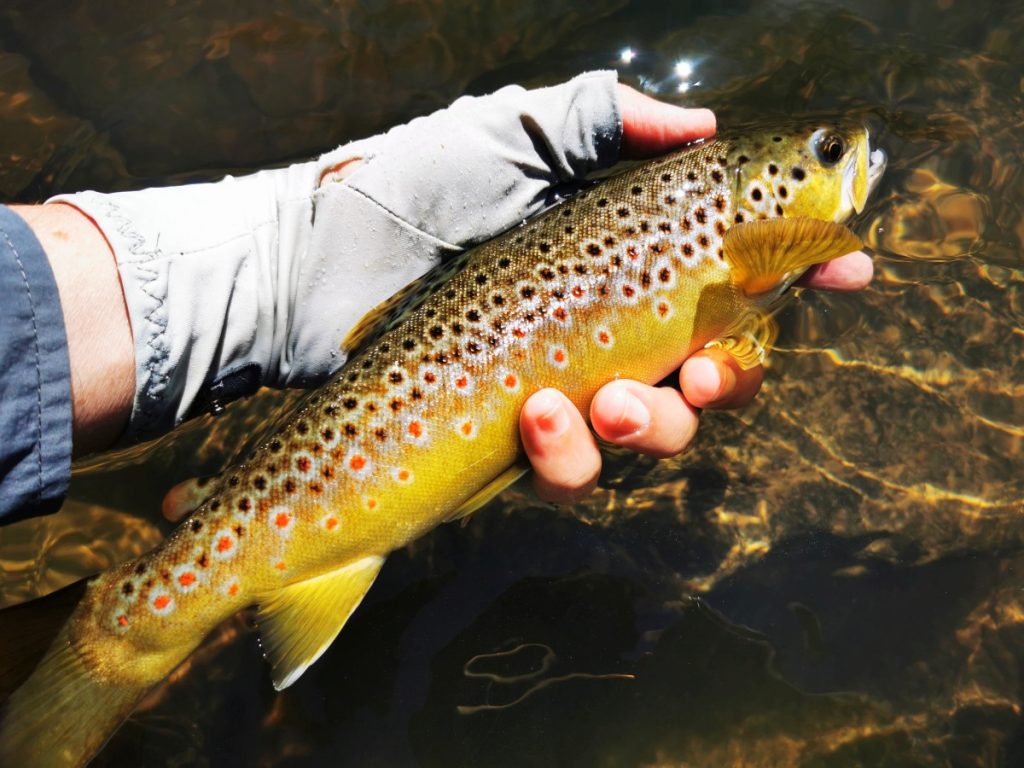
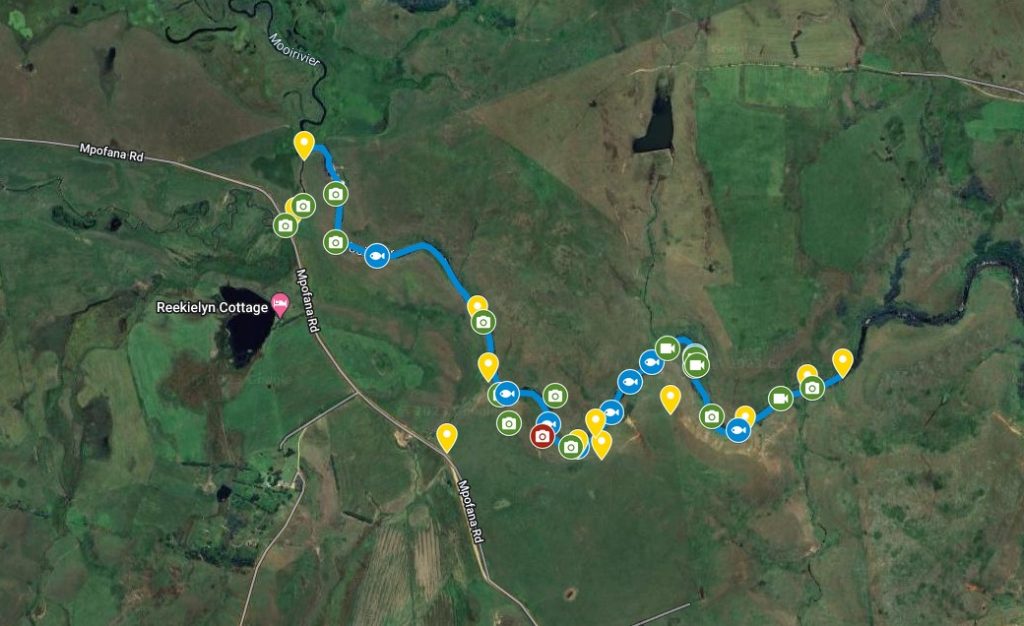
4 Responses
I have to go down to the bottom boundary Andrew – never been there! In fact, I’ve only fished Reekie Lynn once – it was early January, the river was high but fishable and it was Liz’s birthday! I did manage one small brown near the plane trees before I had to get back for the festivities – only just in time.
Bring on the river season!!
I learned to fish on that river and know it really well. But I fear for it these days as last time I was there some years ago all the birds seemed to have gone. We used to have duck, swallows, kingfishers, Tegwaans and occasional exotics. It is an exceptional stretch of river and I am delighted to hear that people do still catch trout there. Please look after it.
Hi Tim,
You will be glad to hear that Reekie Lynn is in good shape. You probably just saw it on a bad day. It is alive with Kingfishers, otter, vultures, Tekwaans, Black and yellow billed duck, and others etc etc. Lots of antelope too (Eland, Reedbuck etc).